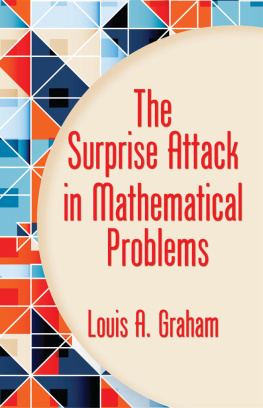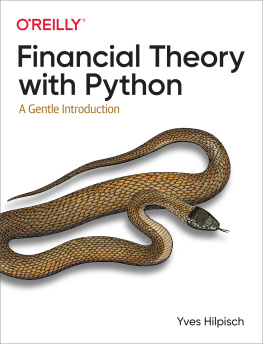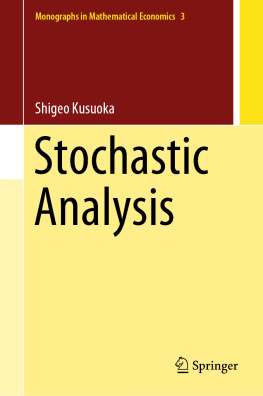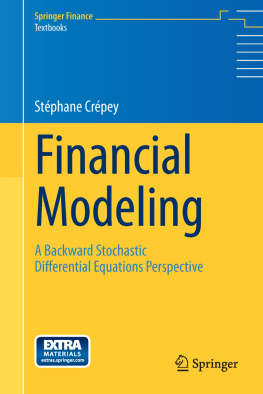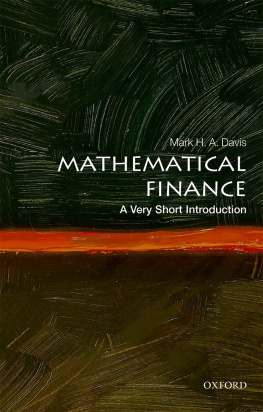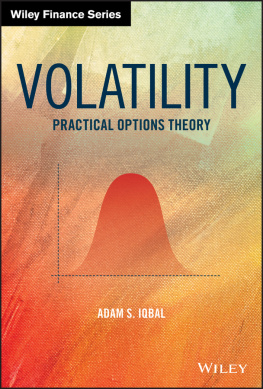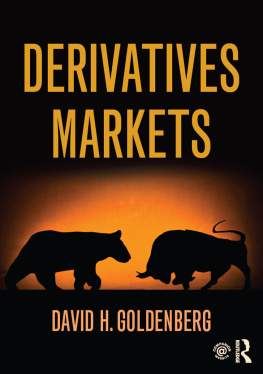Louis Bacheliers
Theory of Speculation
THE ORIGINS OF MODERN FINANCE
Translated and with Commentary by
Mark Davis and Alison Etheridge

Copyright 2006 by Princeton University Press
Published by Princeton University Press,
41 William Street, Princeton, New Jersey 08540
In the United Kingdom: Princeton University Press,
3 Market Place, Woodstock, Oxfordshire OX20 1SY
All rights reserved
ISBN-13: 978-0-691-11752-2 (alk. paper)
ISBN-10: 0-691-11752-7 (alk. paper)
Library of Congress Control Number: 2006928917
A catalogue record for this book is available from the British Library
This book has been composed in Lucida
Typeset by T&T Productions Ltd, London
Printed on acid-free paper 
www.pupress.princeton.edu
Printed in the United States of America
10 9 8 7 6 5 4 3 2 1
Louis Bacheliers Theory of Speculation
Contents
Foreword
Mathematical and other scientific research can sometimes have a beauty akin to artistic masterworks. And, rarely, romance can even arise in how science progresses. One notable example of this is the 1914 discovery by the eminent British mathematician, G. H. Hardy, of the unknown mathematical genius Ramanujanwhat Hardy called the greatest romance in his professional life.
That story began when the morning post brought to Trinity College, Cambridge, a letter from an unknown impoverished Madras clerk. Instead of giving it a cursory glance, Hardy examined with amazement the several enclosed infinite series. In a flash, he realized they were the work of a genius: a few Hardy already knew; maybe at least one was imperfect; but several were so novel that no mere talent could have discovered them. No need here to rehash the story of the RamanujanHardy collaboration and the tragic early death from tuberculosis of Ramanujan.
As told in the preface below, discovery or rediscovery of Louis Bacheliers 1900 Sorbonne thesis, Thorie de la spculation, began only in the middle of the twentieth century, and initially involved a dozen or so postcards sent out from Yale by the late Jimmie Savage, a pioneer in bringing back into fashion statistical use of Bayesian probabilities. In paraphrase, the postcards message said, approximately, Do any of you economist guys know about a 1914 French book on the theory of speculation by some French professor named Bachelier?
Apparently I was the only fish to respond to Savages cast. The good MIT mathematical library did not possess Savages 1914 reference. But it did have something better, namely Bacheliers original thesis itself.
I rapidly spread the news of the Bachelier gem among early finance theorists. And when our MIT PhD Paul Cootner edited his collection of worthy finance papers, on my suggestion he included an English version of Bacheliers 1900 French text. I salute Davis and Etheridge for their present definitive translation, augmented by their splendid commentaries.
What adds to Bacheliers fame as a theorist is that he wrote long before Norbert Wiener provided a coherent basis for differential probability space. And even longer before the It stochastic calculus became available to Robert Merton or Fischer Black.
Even more impressive to lay students of how modern science evolved is that Bachelier beat Albert Einstein to the punch in analyzing what is essentially Brownian motion. Einsteins 1905 physics was impeccable. But as pure mathematics, Bachelier had already overlapped Einsteins findings and beyond that explicated how Fouriers derivation of the partial differential equation of heat applied isomorphically to the diffusions of probabilities. The famous FokkerPlanck and ChapmanKolmogorov equations could, therefore, also carry the name of Bachelier first.
Notions today of Wall Street as a random walk did get an important boost from Bachelier. But earlier, as far back as 1930, Holbrook Workings prolific Stanford research on future prices had documented the similarities between random-number sequences and time profiles of actual wheat and stock prices. One must still acknowledge that doctrines of efficient markets did have anticipations in Bachelier.
Early on, discoverers of Bachelier realized that Bacheliers strict text involved price changes subject to absolute Gaussian distribution. By contrast, limited-liability common stocks can both rise and fall, but none of their prices can, by definition, go negative. Therefore, opportunistically I suggested replacing Bacheliers absolute Gaussian distribution by geometric Brownian motion based on log-Gaussian distributions. Independently, the astronomer M. F. M. Osborne made the same suggestion, based on some analogy with WeberFechner laws in historic psychology.
Novel notions in science naturally invoke opposition from the ruling savants of normal science. That is why Bacheliers mathematics and efficient-market claims met with resistanceresistance from diverse sources.
(1) If Wall Street was only a casino, then must not economic law be denied? That was the accusation of the economists assigned to frame a vote of thanks for (Sir) Maurice Kendalls 1953 Royal Statistical Society lecture that reported quasi-zero serial (Pearsonian) correlations of price changes for future contracts on commodities, for common stocks, and for indexed portfolios of the above. In post-mortem chatter with my friends who had attended that lecture, I mischievously suggested:
Work the other side of the street. Economic law in its purest form would expect rationally anticipated prices to bounce quasi-randomly to incoming shocks from unanticipated future events.
(Most of my own half-dozen expositions of market efficiency, based on martingales rather than white noise, definitely do accord with economic fundamentalism. Working, who was a pioneer in recognizing random components, nevertheless compared carry-overs and seasonal pricings for onions (a) when speculative markets were banned as illegal, and (b) when they were legalized. Under (b), runs of good and bad harvests resulted, respectively, in storage and carry-over patterns that matched closely the linear-programming paths generated by an omniscient Robinson Crusoe; without legal bourses, what later became known as intertemporal Pareto non-optimality was the rule in the Hobbesian jungle.)
(2) Old-guard resistance to post-Bachelier finance is well exemplified by the distinguished Nobelist and libertarian Milton Friedman. Early in the 1950s he had reacted adversely to Harry Markowitzs paradigm of portfolio optimization by mean-variance quadratic programming. It was not economics; nor was it at all interesting mathematics. Nor was this a hasty, tentative diagnosis. Forty years later in interviews with Reuters and the Associated Press, this truly great economist opined that the names of Markowitz, Sharpe, and Merton Miller would not be on connoisseurs lists of 100 likely Nobel candidates. In some university junior common rooms, this incident brought into remembrance Max Plancks methodological dictum: science progresses funeral by funeral.
(3) Decades ago it was still not uncommon for most economists to doubt the usefulness of highfalutin mathematics for a social science like economics. When they overheard palaver about, say, MertonIt stochastic calculus, they were agin it. A different reaction comes from the lively twenty-first century school of behavioral economists. These are well aware that few Wall Street locals can compute whether independent tosses of two fair coins will be more likely to result in both heads and tails rather than in two heads or two tails. So, how can their markets become and stay efficient?


